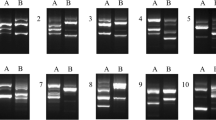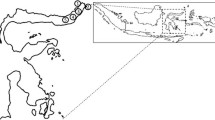Abstract
Helicobacter pylori is a genetically diverse bacterial species, which has facilitated adaptation to new hosts and persists worldwide. The main objective of this study was to explore intra-familial transmission of H. pylori in Bangladesh. We characterized H. pylori in 35 families including 138 family members using random amplified polymorphic DNA (RAPD) fingerprinting. Forty-six percent of H. pylori isolated from the mother shared a related genotype with strains isolated from their children. Twenty-nine percent of H. pylori isolates of the mother are related to the youngest children. Only 6% of the parents shared related genotype of H. pylori. These findings suggest that mother-to-child transmission occurs in early childhood and is the most probable route of transmission of H. pylori in Bangladesh.



Similar content being viewed by others
References
Anonymous (1983) Unidentified curved bacilli on gastric epithelium in active chronic gastritis. Lancet 1(8336):1273–1275
Suerbaum S, Michetti P (2002) Helicobacter pylori infection. N Engl J Med 347(15):1175–1186
Sarker SA, Mahalanabis D, Hildebrand P, Rahaman MM, Bardhan PK, Fuchs G, Beglinger C, Gyr K (1997) Helicobacter pylori: prevalence, transmission, and serum pepsinogen II concentrations in children of a poor periurban community in Bangladesh. Clin Infect Dis 25(5):990–995
Granstrom M, Tindberg Y, Blennow M (1997) Seroepidemiology of Helicobacter pylori infection in a cohort of children monitored from 6 months to 11 years of age. J Clin Microbiol 35(2):468–470
Rowland M, Daly L, Vaughan M, Higgins A, Bourke B, Drumm B (2006) Age-specific incidence of Helicobacter pylori. Gastroenterology 130(1):65–72 quiz 211
Kauser F, Khan AA, Hussain MA, Carroll IM, Ahmad N, Tiwari S, Shouche Y, Das B, Alam M, Ali SM, Habibullah CM, Sierra R, Megraud F, Sechi LA, Ahmed N (2004) The cag pathogenicity island of Helicobacter pylori is disrupted in the majority of patient isolates from different human populations. J Clin Microbiol 42(11):5302–5308
Kate V, Ananthakrishnan N, Ratnakar C, Badrinath S (2001) Anti-H. pylori IgG seroprevalence rates in asymptomatic children and adults from South India. Indian J Med Microbiol 19(2):20–25
Goodman KJ, Correa P (1995) The transmission of Helicobacter pylori. A critical review of the evidence. Int J Epidemiol 24(5):875–887
Drumm B, Perez-Perez GI, Blaser MJ, Sherman PM (1990) Intrafamilial clustering of Helicobacter pylori infection. N Engl J Med 322(6):359–363
Goodman KJ, Correa P (2000) Transmission of Helicobacter pylori among siblings. Lancet 355(9201):358–362
Tindberg Y, Bengtsson C, Granath F, Blennow M, Nyren O, Granstrom M (2001) Helicobacter pylori infection in Swedish school children: lack of evidence of child-to-child transmission outside the family. Gastroenterology 121(2):310–316
Sarker SA, Rahman MM, Mahalanabis D, Bardhan PK, Hildebrand P, Beglinger C, Gyr K (1995) Prevalence of Helicobacter pylori infection in infants and family contacts in a poor Bangladesh community. Dig Dis Sci 40(12):2669–2672
Rothenbacher D, Winkler M, Gonser T, Adler G, Brenner H (2002) Role of infected parents in transmission of Helicobacter pylori to their children. Pediatr Infect Dis J 21(7):674–679
Bamford KB, Bickley J, Collins JS, Johnston BT, Potts S, Boston V, Owen RJ, Sloan JM (1993) Helicobacter pylori: comparison of DNA fingerprints provides evidence for intrafamilial infection. Gut 34(10):1348–1350
Han SR, Zschausch HC, Meyer HG, Schneider T, Loos M, Bhakdi S, Maeurer MJ (2000) Helicobacter pylori: clonal population structure and restricted transmission within families revealed by molecular typing. J Clin Microbiol 38(10):3646–3651
Roma-Giannikou E, Karameris A, Balatsos B, Panayiotou J, Manika Z, Van-Vliet C, Rokkas T, Skandalis N, Kattamis C (2003) Intrafamilial spread of Helicobacter pylori: a genetic analysis. Helicobacter 8(1):15–20
Wang JT, Sheu JC, Lin JT, Wang TH, Wu MS (1993) Direct DNA amplification and restriction pattern analysis of Helicobacter pylori in patients with duodenal ulcer and their families. J Infect Dis 168(6):1544–1548
Kivi M, Johansson AL, Reilly M, Tindberg Y (2005) Helicobacter pylori status in family members as risk factors for infection in children. Epidemiol Infect 133(4):645–652
Kivi M, Tindberg Y, Sorberg M, Casswall TH, Befrits R, Hellstrom PM, Bengtsson C, Engstrand L, Granstrom M (2003) Concordance of Helicobacter pylori strains within families. J Clin Microbiol 41(12):5604–5608
Suerbaum S, Smith JM, Bapumia K, Morelli G, Smith NH, Kunstmann E, Dyrek I, Achtman M (1998) Free recombination within Helicobacter pylori. Proc Natl Acad Sci USA 95(21):12619–12624
Raymond J, Thiberg JM, Chevalier C, Kalach N, Bergeret M, Labigne A, Dauga C (2004) Genetic and transmission analysis of Helicobacter pylori strains within a family. Emerg Infect Dis 10(10):1816–1821
Lundin A, Bjorkholm B, Kupershmidt I, Unemo M, Nilsson P, Andersson DI, Engstrand L (2005) Slow genetic divergence of Helicobacter pylori strains during long-term colonization. Infect Immun 73(8):4818–4822
Sarker SA, Nahar S, Rahman M, Bardhan PK, Nair GB, Beglinger C, Gyr N (2004) High prevalence of cagA and vacA seropositivity in asymptomatic Bangladeshi children with Helicobacter pylori infection. Acta Paediatr 93(11):1432–1436
Ausubel FM, Brent R, Kingston RE, Moore DD, Seidman JG, Smith JA, Struhl K (ed) (1993) Current protocols in molecular biology. Greene Publishing and Wiley-Interscience, New York, NY
Megraud F (1995) Transmission of Helicobacter pylori: faecal-oral versus oral-oral route. Aliment Pharmacol Ther 9(Suppl 2):85–91
Sinha SK, Martin B, Gold BD, Song Q, Sargent M, Bernstein CN (2004) The incidence of Helicobacter pylori acquisition in children of a Canadian First Nations community and the potential for parent-to-child transmission. Helicobacter 9(1):59–68
Chalkauskas H, Kersulyte D, Cepuliene I, Urbonas V, Ruzeviciene D, Barakauskiene A, Raudonikiene A, Berg DE (1998) Genotypes of Helicobacter pylori in Lithuanian families. Helicobacter 3(4):296–302
Gibson JR, Slater E, Xerry J, Tompkins DS, Owen RJ (1998) Use of an amplified-fragment length polymorphism technique to fingerprint and differentiate isolates of Helicobacter pylori. J Clin Microbiol 36(9):2580–2585
Li L, Genta RM, Go MF, Gutierrez O, Kim JG, Graham DY (2002) Helicobacter pylori strain and the pattern of gastritis among first-degree relatives of patients with gastric carcinoma. Helicobacter 7(6):349–355
Miehlke S, Genta RM, Graham DY, Go MF (1999) Molecular relationships of Helicobacter pylori strains in a family with gastroduodenal disease. Am J Gastroenterol 94(2):364–368
Nwokolo CU, Bickley J, Attard AR, Owen RJ, Costas M, Fraser IA (1992) Evidence of clonal variants of Helicobacter pylori in three generations of a duodenal ulcer disease family. Gut 33(10):1323–1327
Taneike I, Tamura Y, Shimizu T, Yamashiro Y, Yamamoto T (2001) Helicobacter pylori intrafamilial infections: change in source of infection of a child from father to mother after eradication therapy. Clin Diagn Lab Immunol 8(4):731–739
van der Ende A, Rauws EA, Feller M, Mulder CJ, Tytgat GN, Dankert J (1996) Heterogeneous Helicobacter pylori isolates from members of a family with a history of peptic ulcer disease. Gastroenterology 111(3):638–647
Kivi M, Tindberg Y (2006) Helicobacter pylori occurrence and transmission: a family affair? Scand J Infect Dis 38(6-7):407–417
Goldman C, Barrado A, Janjetic M, Balcarce N, Cueto Rua E, Oshiro M, Calcagno ML, Sarrasague MM, Fuda J, Weill R, Zubillaga M, Perez-Perez GI, Boccio J (2006) Factors associated with H. pylori epidemiology in symptomatic children in Buenos Aires, Argentina. World J Gastroenterol 12(33):5384–5388
Mahalanabis D, Rahman MM, Sarker SA, Bardhan PK, Hildebrand P, Beglinger C, Gyr K (1996) Helicobacter pylori infection in the young in Bangladesh: prevalence, socioeconomic and nutritional aspects. Int J Epidemiol 25(4):894–898
Akopyanz N, Bukanov NO, Westblom TU, Kresovich S, Berg DE (1992) DNA diversity among clinical isolates of Helicobacter pylori detected by PCR-based RAPD fingerprinting. Nucleic Acids Res 20(19):5137–5142
Dubois A, Berg DE, Incecik ET, Fiala N, Heman-Ackah LM, Del Valle J, Yang M, Wirth HP, Perez-Perez GI, Blaser MJ (1999) Host specificity of Helicobacter pylori strains and host responses in experimentally challenged nonhuman primates. Gastroenterology 116(1):90–96
Yakoob J, Hu G, Fan X, Zhang Z (2001) Helicobacter pylori detection in Chinese subjects: a comparison of two common DNA fingerprinting methods. Br J Biomed Sci 58(4):239–243
Allaker RP, Young KA, Hardie JM, Domizio P, Meadows NJ (2002) Prevalence of Helicobacter pylori at oral and gastrointestinal sites in children: evidence for possible oral-to-oral transmission. J Med Microbiol 51(4):312–317
Kuo CH, Poon SK, Su YC, Su R, Chang CS, Wang WC (1999) Heterogeneous Helicobacter pylori isolates from H. pylori-infected couples in Taiwan. J Infect Dis 180(6):2064–2068
Suzuki J, Muraoka H, Kobayasi I, Fujita T, Mine T (1999) Rare incidence of interspousal transmission of Helicobacter pylori in asymptomatic individuals in Japan. J Clin Microbiol 37(12):4174–4176
Falush D, Kraft C, Taylor NS, Correa P, Fox JG, Achtman M, Suerbaum S (2001) Recombination and mutation during long-term gastric colonization by Helicobacter pylori: estimates of clock rates, recombination size, and minimal age. Proc Natl Acad Sci USA 98(26):15056–15061
Acknowledgments
This research was conducted in the International Centre for Diarrhoeal Diseases Research, Bangladesh (ICDDR, B), which is supported by countries and agencies that share its concern for the health problems of developing countries. This program is entirely supported by SIDA/SAREC (Grant #GR-00384, Research Protocol Number 2005-010). ICDDR, B acknowledges with gratitude the commitment of SIDA to the Centre’s research efforts. The authors thank Dr. Habiba Yeasmin, Dr. Shamima Sultana and the field staffs of Nandipara Clinic of ICDDR, B for their help in the study.
Author information
Authors and Affiliations
Corresponding author
Rights and permissions
About this article
Cite this article
Nahar, S., Kibria, K.M.K., Hossain, M.E. et al. Evidence of intra-familial transmission of Helicobacter pylori by PCR-based RAPD fingerprinting in Bangladesh. Eur J Clin Microbiol Infect Dis 28, 767–773 (2009). https://doi.org/10.1007/s10096-008-0699-8
Received:
Accepted:
Published:
Issue Date:
DOI: https://doi.org/10.1007/s10096-008-0699-8




